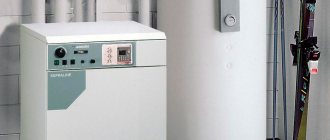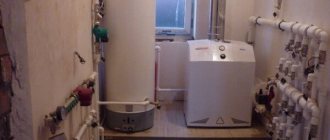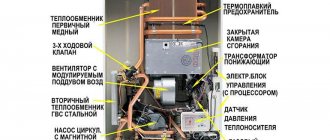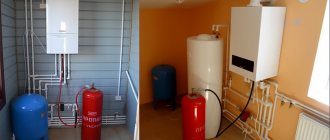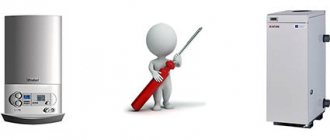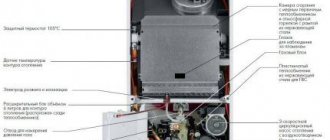Of all sources of thermal energy, gas boilers are considered the most efficient and economical.
They are used both in private heating systems and in powerful industrial-level thermal stations.
The capabilities and reliability of gas units have contributed to the development of a large number of designs with various features, a set of functions and other qualities.
The units of medium and low power, which are used for heating private houses, are particularly diverse.
Let's look at the two most common groups - wall and floor.
Wall-mounted gas boilers
Wall-mounted gas boilers were developed for use in small residential premises where it is not possible to allocate a separate room for the boiler room.
They are mounted in a hinged manner on strong (load-bearing) walls, so the weight and dimensions of the units are limited . As a rule, the power of wall-mounted boilers does not exceed 40 kW, and the dimensions approximately correspond to the format of wall cabinets in kitchen units.
Apart from size and weight, wall-mounted boilers do not have any fundamental differences from floor-standing models and operate according to general rules.
Varieties
There are different designs of wall-mounted boilers. They can be divided according to their own characteristics.
By feature set:
- single-circuit. Designed only for heating the coolant and supplying it to the heating system;
- double-circuit. Capable of simultaneously heating the coolant and preparing hot water for domestic needs.
By type of combustion chamber:
- atmospheric. The traditional design of a gas boiler, in which the combustion process takes place in an open burner with air intake directly from the room. Smoke removal occurs in the usual way, under the influence of stove-type draft;
- turbocharged. The combustion chamber is isolated from the room atmosphere, which ensures cleanliness and the absence of unwanted components. The combustion air supply is provided by a turbocharger fan. Excess pressure arises, which helps remove smoke from the boiler. Typically, such structures use their own horizontal chimney of the coaxial type.
By heat exchanger type:
- separated. The boilers are equipped with either one (primary) unit or two - the primary heats the coolant, and the secondary (plate) indirectly prepares hot water in flow mode;
- combined (bithermic) . The design of this unit is close to coaxial types. The coolant flows through one cavity, and water for domestic needs flows through the other. The design is effective, avoids temperature surges, but very quickly becomes covered with a layer of lime deposits that are practically impossible to clean.
According to heat exchanger material:
- steel. Used on inexpensive models;
- copper. Used on products from top manufacturers. Provides high heat transfer and durability.
NOTE!
Wall-mounted units have all the capabilities and are produced in all existing structural types. The only type that is not produced in a wall-mounted version is the non-volatile boiler.
Advantages and disadvantages
The advantages of wall-mounted gas boilers include:
- compactness, light weight, ability to fit harmoniously into the interior of the room;
- wide choice of functionality and power of units;
- reliability, stability;
- Ease of Management;
- low gas consumption;
- ease of maintenance and repair.
Disadvantages can be considered:
- installation of units is labor-intensive and requires the use of special equipment;
- Boiler power is limited due to the need to reduce the load on load-bearing surfaces.
The existing disadvantages of wall-mounted boilers are not a serious obstacle for users. Most owners of relatively small rooms prefer to buy wall-mounted models.
Recommendations for selection
For residents of rural areas where there are power outages, there is no question of choosing a floor-standing or wall-mounted boiler option. If the operation of the heat generator depends on the power supply, then the costs of purchasing and operating a gasoline electric generator will be too high, which will greatly increase the cost of heating. The second problem is calling service personnel to repair or service a high-tech wall-mounted unit. There remains one option - a simple floor-standing boiler equipped with an open combustion chamber.
In other cases, with a good power supply, the advantage remains on the side of wall-mounted gas boilers.
They are compact, inexpensive and have an aesthetic appearance. Homeowners who don't need a lot of features can choose a simple, inexpensive model. Residents of apartments or private houses where a chimney is not built have the opportunity to install a wall-mounted heat generator with a closed chamber and pressurization. To remove gases, a short coaxial chimney will be used, leading directly through the wall.
Floor standing gas boilers
Floor-standing gas boilers are installed directly on the floor or, if it is wooden, on a non-combustible stand. This removes restrictions on the weight and dimensions of the unit, but introduces requirements for the room - floor-standing boilers require a separate room with a full-fledged door and window opening.
At the same time, the capabilities of floor-standing boilers are noticeably higher, especially with regard to DHW parameters. All single-circuit floor-standing boilers can be connected to an external indirectly heated storage boiler, which allows you to obtain a full supply of hot water, which is noticeably ahead of the parameters of double-circuit models.
The basic principle of operation of the units is no different from wall-mounted models; the only difference is in power, size and installation conditions .
Kinds
Floor-standing gas boilers are manufactured in all known design options. They can be divided into groups according to different characteristics.
By functionality:
- single-circuit. They are used only for heating the coolant. When connecting an external boiler, they are able to provide the room with hot water at the level of centralized water supply;
- double-circuit. They are capable of preparing hot water for household needs in parallel with heating the coolant.
By heat transfer method:
- convection Conventional heating of liquid in the flame of a gas burner;
- condensation A two-stage heating of the coolant is carried out - first in the condensation chamber from the heat of the exhaust smoke, and then in the usual way. The design has specific conditions for full operation - either a low-temperature circuit (warm floor) is needed, or the difference between external and internal temperatures should not exceed 20°;
- parapet. Units capable of operating in small spaces without a heating circuit. There are holes in the housing that provide circulation of hot air according to the convector principle.
According to heat exchanger material:
- steel. Stainless steel up to 3 mm thick is used;
- copper. As a rule, a coil is installed that has high durability and heat transfer;
- cast iron Used on powerful models that require stable and efficient operation of the unit.
By type of power supply:
- volatile. Boilers, the design of which uses devices that require connection to the network;
- non-volatile. Units capable of operating without being connected to a power supply.
IMPORTANT!
Non-volatile boilers are good in conditions of unstable energy supply, or in remote villages.
Advantages and disadvantages
The advantages of floor-standing boilers include::
- high power, ability to heat large areas;
- reliability, resistance to operational loads;
- the ability to connect some models into a high-power cascade;
- a wide selection of models with different design features and power;
- ease of installation;
- control of floor-standing boilers is clear and accessible to any user.
Disadvantages are considered:
- To install floor-standing boilers, you need a special room with lockable doors and a window opening;
- they are not suitable for use in apartments or small houses;
- high power automatically means high fuel consumption.
NOTE!
Despite the existing shortcomings, the demand for floor-standing boilers is consistently high. Users prefer the reliability and durability that floor-standing boilers offer.
Which boiler is better to choose
In addition to the main technical characteristics and price, the choice of heating unit is influenced by operating conditions and recommendations of specialists who regularly service gas-using installations in private homes.
It is noteworthy that these workers in most cases recommend buying a gas floor-standing boiler with an atmospheric burner and without any “bells and whistles”. This is understandable: such equipment is easier to maintain, and it breaks down quite rarely.
Taking into account practical experience in the field of heating private housing and reviews of various types of heating equipment powered by natural gas, we give the following recommendations for choosing a heat source:
- If electricity is supplied to your apartment or house almost without interruption, then preference should be given to wall-mounted models of heat generators. They take up less space, are cheaper in price and more practical, since they are a ready-made mini-boiler room.
- When you need to provide hot water to 1 bathroom and a tap in the kitchen, also feel free to purchase a hanging boiler of the required power. Its DHW capacity is just enough for two consumers.
- In a private house where frequent or long-term power outages occur, you need to install a non-volatile gas boiler of a floor-standing type. It will be able to work without problems with a gravitational open heating system, where the coolant moves by gravity.
- In large cottages, where several different heating systems and 2-3 heat generators using different types of fuel are used for heating, it is appropriate to install a floor-standing gas unit without a built-in pump and expansion tank. It is better to install these elements separately, since their operation will be connected with the operation of other heaters.
The most budget option for small houses (up to 150 m²) is a parapet non-volatile boiler with a direct chimney pipe exiting through the wall. These are produced with limited power - up to 15 kW. There is no need to specially build a chimney for it.
An important point: when choosing a heating unit for a closed heating system, pay attention to the operating pressure (indicated in the passport). It should be 3 Bar. For open water systems, a pressure of 2 bar is sufficient.
There are situations when it is impossible to install a suspended heat generator due to various reasons, for example:
- in the kitchen the walls are occupied by cabinets and household appliances;
- the building structure or its finishing does not allow hanging a unit weighing 50 kg or more;
- in the boiler room there is no space on the walls or it is difficult to install pipelines.
Then all that remains is to purchase a floor-standing boiler of similar power and install it in a convenient location. When we have decided on the installation method, we move on to choosing a heating installation based on the operating principle.
Operating principle
The operating principle of both types of boilers is the same. The main design elements are a gas burner and a heat exchanger, combined into a single unit.
The coolant enters the heat exchanger, receives a high temperature there and is discharged to the secondary unit. In it, thermal energy is partially spent on preparing hot water. After this, the liquid passes into a three-way valve, mixes in a given proportion with the colder return flow and receives a temperature determined by the current operating mode.
After this, the coolant leaves the boiler and enters the heating circuit, where it makes a circle and returns to the boiler as a return flow. The air is supplied by a turbofan, which also ensures smoke exhaust.
Circulation occurs under the action of a circulation pump. The operation is constantly monitored by a control board and a system of sensors that can detect any problems and immediately notify the owner about them.
Which is better – wall-mounted or floor-mounted?
The advantage of one type or another can only be indicated in relation to a specific room.
If you have an apartment or a small country house that does not have extra space, you should use a wall-mounted boiler . Floor-mounted structures are good in large houses, where it is possible to install the boiler in a separate room.
As a rule, a boiler room is designed at the stage of preparing working drawings of the house. In terms of structural or operational advantages, both types have no primacy .
All comparisons can only be made in relation to the specific location of installation or use.
What to choose
For clarity, let’s make a table of the features of both types:
| Characteristics and Features | Wall mounted | Floor-standing |
| Functionality | Full set | |
| Durability | Depends on the operating mode. On average, from 10 to 20 years | |
| Power | Up to 50 kW | Up to 500 kW |
| Power supply | Energy-dependent designs | Volatile and non-volatile designs |
| Price | Average | Medium and high |
| Weight, dimensions | Small, medium | Medium, large |
| Difficult to manage and maintain | Average | |
Results - which is better?
Floor-standing models have expanded capabilities regarding DHW supply. If you use an external boiler, the performance of such a kit will significantly exceed the capabilities of dual-circuit models, both wall-mounted and floor-mounted.
At the same time, wall-mounted boilers are compact, do not require extra space, and consume a small amount of fuel. Therefore, comparing them from the point of view of “better or worse” is incorrect.
Each boiler has its own optimal conditions, in which it is noticeably superior to all alternative options.
What influences long-term performance?
Wall-mounted, unlike floor-standing gas boilers, often break due to small power surges. In this case, the main board burns out. Replacing it costs a lot of money. An important point: floor-standing boilers are adapted to process water of poor quality. In wall-mounted boilers, heat exchangers are often made poorly and therefore easily become clogged. When choosing a wall-mounted boiler, do not skimp on cost.
If your tap water is of high hardness and salinity, it is better to purchase a floor-standing boiler with a boiler. They are not afraid of salt deposits.
Also, do not forget about the further maintenance of your gas boiler. Remember: the greater its power, the more expensive annual maintenance by gas services will be.
To summarize and answer the question of whether to choose a wall-mounted or floor-standing boiler, it is necessary to take into account not only personal preferences and the appearance of the gas boiler, but also the following factors: room area, power outages, financial capabilities and water quality.
For a small house with a stable supply of electricity and high-quality piped water, it is better to choose a wall-mounted two-stage boiler. If you choose high-quality heating equipment, it will serve you for many decades and bring a lot of benefit and warmth.
For a room with a large area and interruptions in the power supply, a powerful floor-standing boiler is suitable.
After analyzing all these factors, comparing the conditions in which you live with the characteristics of the boilers, you can make the best choice in favor of one or another boiler. The main thing is not to rush, do not be fooled by cheap advertising. Take the time to choose the boiler that is right for you.
Detailed video on choosing a wall-mounted or floor-standing gas boiler
